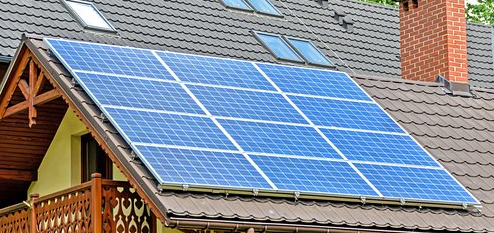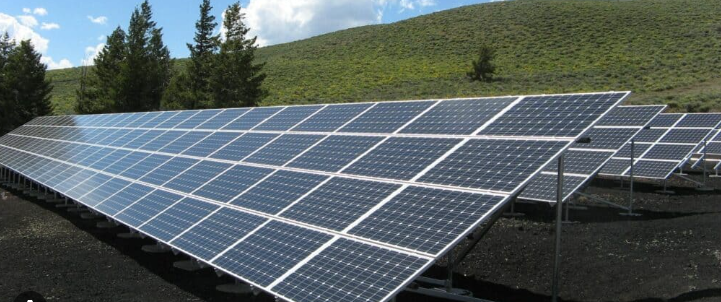Different Types Of Solar Panels & Their Efficiencies
The specific type of solar panel you install is one of the biggest factors in your system's long-term performance and final cost. Since there are several technologies on the market, it's helpful to know how they differ. Panel efficiency, in particular, will determine how much power you can generate and the amount of roof space you'll need. This guide walks through the most common solar panel options to help you find the right fit for your home and budget.
What Is Solar Panel Efficiency?
Solar panel efficiency is a measure of how well a panel can convert the sun's energy into usable electrical energy. Presented as a percentage, the number informs you of how much of the sun's energy that hits the panel's surface is converted into electricity. For example, a solar panel with a 20% efficiency rating converts 20% of the sunlight it receives into electrical energy. The main factors that determine this efficiency are the material type, the physical design of the panel, and the technology behind it. A higher efficiency rating is important in that more power can be generated from a smaller surface area. This is especially crucial for installations where space is limited, like residential rooftops. More efficiency ultimately means more energy production and can result in greater long-term savings on your electrical bills.
Types of Solar Panels
The market has a variety of solar panels with different characteristics. Monocrystalline, polycrystalline, thin-film, bifacial, and PERC panels are the most popular ones.
Monocrystalline Solar Panels
Monocrystalline panels are made from a single crystal of pure silicon. It is this uniformity that gives them their distinctive black color and rounded corners.
Efficiency and Performance:
These panels are the most efficient of the popular types, and their efficiency usually falls in the range of 15% to 22%. Their high efficiency means they are a great option for homes with small roof space since they can produce more energy per square foot. They also last long, usually over 25 years with matching warranties.
Cost and Production:
The production process, which includes the growth of a big single silicon crystal and then cutting it into wafers, is energy-intensive and has some material loss. As such, monocrystalline panels tend to be the priciest option.
Polycrystalline Solar Panels
Polycrystalline panels are produced by melting several silicon crystals together and casting them into a square mold. This is what gives the panel its characteristic blue, marbled look.
Polycrystalline panels have efficiency ratings of 13% to 18% and are therefore less efficient than monocrystalline panels. This requires a greater installation area to generate the same power. They also have a slightly shorter lifespan, generally lasting 20 to 25 years.
The production process for polycrystalline silicon is less complicated and produces less waste, so these panels are a less expensive option. They are an affordable choice among consumers who have a lot of space to install them.
Thin-Film Solar Panels
Thin-film solar panels are constructed by depositing one or more thin layers of photovoltaic material onto a substrate, such as glass, plastic, or metal.
This category of panels has the lowest efficiency, generally between 10% and 12%. Their lower power output means they require the most space to generate a given amount of electricity. They also tend to have a shorter lifespan and are less durable than crystalline silicon panels.
Manufacturing thin-film panels is less costly and requires fewer materials. Their lightweight and flexible nature makes them suitable for large-scale commercial or utility installations where space is not a primary concern.
Bifacial Solar Panels
Bifacial solar panels are designed to capture sunlight from both the front and the back of the panel. This dual-sided absorption can significantly increase energy production.
The front side of a bifacial panel has an efficiency comparable to monocrystalline panels, around 16% to 20%. However, by capturing reflected light from the ground or roof surface, the total energy yield can be substantially higher. They perform exceptionally well in environments with high surface reflectivity, such as areas with snow, white rooftops, or light-colored ground cover.
Cost and Installation:
These panels are more expensive and require specialized mounting systems that elevate the panel to allow light to reach the rear side. The installation is more complex and must be carefully planned to maximize the benefit of the bifacial technology.


PERC (Passivated Emitter and Rear Contact) Solar Panels
Traditional monocrystalline cells are better with PERC technology. To do this, a passivation layer is put on the back of the solar cell. This helps to reflect light back through the cell, which lowers energy waste and raises efficiency.
PERC panels have better efficiency ratings than monocrystalline panels. These ratings are usually between 18% and 23%. They also work better when there isn't much light or when the temperature is higher. This makes the panel last longer and work better over its lifetime.
Cost and Availability:
Because they need an extra step in the making process, PERC panels are more expensive than monocrystalline panels. They're becoming more popular, but you might not be able to find them as easily as other types of panels.
Solar Panel Efficiency Comparison: At a Glance
To summarize the key differences we've discussed, the table below provides an at-a-glance comparison of the main solar panel types.
| Type of Solar Panel | Efficiency (%) | Cost (per Watt) | Lifespan | Ideal Use Case |
| Monocrystalline | 15-22% | High | 25+ years | Limited space, high-efficiency needs |
| Polycrystalline | 13-18% | Moderate | 20-25 years | Budget-conscious, large installations |
| Thin-Film | 10-12% | Low | 15-20 years | Large, flexible installations |
| Bifacial | 16-20% | High | 25+ years | Snowy areas, reflective surfaces |
| PERC | 18-23% | Moderate-High | 25+ years | Residential areas with high sunlight |
As the table clearly shows, choosing a panel often involves a trade-off between cost and efficiency. However, selecting the right type of panel is only the first step. The actual real-world performance of your system will also depend on several key external factors.
Factors Affecting Solar Panel Efficiency
The rated efficiency of a panel is just a starting point. In the real world, several factors will influence how much power your system actually generates:
Heat
While they need sunshine, solar panels ironically become less efficient in extreme heat. As a panel's temperature rises, its power output drops. This is a key consideration for performance in very hot climates.
Sunlight Exposure & Angle
Panels generate the most power when they receive intense, direct sunlight. Performance is affected by your location, the time of day, and the season. For best results, panels should be angled so sunlight hits them as close to perpendicular as possible.
Shading
Anything that casts a shadow on your panels—like trees, other buildings, or even significant dirt and debris—will reduce their energy output. This is a bigger deal than many realize, as even partially shading one panel can significantly lower the performance of the whole system.
Installation Quality
A professional installation is crucial for optimal performance. Proper positioning to maximize sun exposure, secure mounting, and correct wiring all ensure you're minimizing energy loss.
Maintenance
Over time, dust, pollen, and grime can cover your panels. Keeping them clean and free of debris is important for maintaining their peak efficiency.
Age (Degradation)
Like most technologies, solar panels slowly lose a small amount of efficiency as they age. This normal process is called degradation. Manufacturers issue warranties that guarantee a certain level of production (typically 80-85% of original output) after 25 years.
How to Choose the Right Solar Panel for Your Needs
Ready to find the right panels? You can narrow down the best option for your home or business by working through these key steps.
Calculate Your Energy Needs
Start by looking at your past electricity bills to determine how much energy your household or business typically uses. This will tell you how large of a solar power system you need to build.
Assess Your Space and Budget
Next, consider your available roof space and your budget. This is often the biggest factor in the decision.
- For limited space or to maximize power: High-efficiency monocrystalline or PERC panels are likely the best investment.
- For larger areas on a tighter budget: Polycrystalline panels provide a cost-effective, reliable solution.
Factor in Your Local Climate
As we've learned, different panels perform better in certain environments.
- For very hot climates: The performance of thin-film panels can be more stable in extreme heat.
- For regions with heavy snow: Bifacial panels are an excellent option, as they can generate power from light reflected off the snow.
Think Long-Term
Finally, view your solar system as a long-term investment. Compare the lifespan, warranty, and degradation rate of different panels. Balance the higher upfront cost of premium panels against their potential for greater energy savings and durability over the next 25+ years.


Power Your Future Wisely!
Making an educated choice is the first step toward energy independence. You can build a solar power system that not only meets your energy needs but also gives you long-term value by carefully weighing the differences in how well they work, how much they cost, and how well they fit your surroundings. If you put in solar panels with care, you will get the most financial and environmental benefits.
FAQs About Types Of Solar Panels & Their Efficiencies
Q1: Is it always worth paying more for the most efficient solar panels?
Not all the time. The best pick depends on how much money you have and how much space you have. It's smart to pay more for high-efficiency panels if you have a small roof because they let you make the most power in a small space. If you are on a tighter budget and have a big, sunny roof, you can often reach your energy goals more easily by putting up more panels that aren't as efficient but are still good quality.
Q2: What happens after a solar panel's 25-year warranty ends? Does it stop working?
That's not true. It still works. The 25-year warranty promises a certain amount of performance, usually that the panel will still make at least 80–85% of the power it did when it was first installed. After the guarantee period is over, the panel will still make electricity for many more years, but it will produce less and less power over time. It is still a strong and long-lasting source of energy.
Q3: My roof has some unavoidable shade. Does that mean I can't install solar panels?
Color doesn't always make or break a deal. A roof that doesn't get shaded is best, but current solar systems can work with some shade. Each panel can work on its own thanks to technologies like microinverters and power optimizers. This means that even if one or two panels are briefly shaded, the system can still produce power at its full level. This means that solar is a good choice for many homes that get some shade.